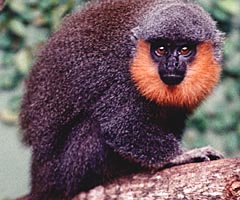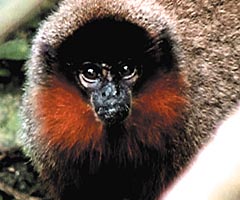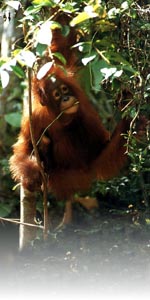RIO DE JANEIRO, Brazil (June 23, 2002 2:32 p.m. EDT) - Scientists working in Brazil's central Amazon have discovered two new monkey species that are about the size of small cats, Conservation International announced Sunday. Two new Amazon monkey species announced

By MICHAEL ASTOR, Associated PressThe monkeys were discovered by Marc Van Roosmalen, a Dutch scientist working at Brazil's National Institute for Amazon Research in Manaus, 1,800 miles northwest of Rio de Janeiro. Van Roosmalen works in a little-explored region of the Amazon near the confluence of the Madeira and Tapajos rivers.
Full scientific descriptions of the monkeys, Callicebus bernardi and Callicebus stephennashi, were published by the peer-review journal Neotropical Primates.
"This once again demonstrates how little we know about biodiversity. These are the 37th and 38th new primate species described since 1990," said Conservation International's President Russell Mittermeier, a co-author of the scientific descriptions.
Van Roosmalen discovered the bernardi monkey - named after Holland's Prince Bernhard - between the east bank of Madeira river and the lower reaches of the Aripuana river.
He found it accidentally while traveling in the region searching for another new species, the dwarf marmoset, which a local fisherman brought to his door in 1996 because he knew Van Roosmalen cared for orphaned monkeys.
The bernardi monkey is remarkable for its dark orange sideburns, chest and inner sides of its limbs. It has a reddish-brown back and a white-tipped black tail.
The bernardi's head and body measure about 15 inches and the tail another 22 inches. An average individual weighs about 33 ounces.
Van Roosmalen found the second monkey last year while conducting a scientific survey near the Purus river with his son, Tomas.
The stephennashi is a silver monkey with a black forehead and red sideburns, chest and red on the inner sides of its limbs. Its head and body measures about 11 inches and the tail another 17 inches. An average individual weighs about 24 ounces.
The new monkeys are the fourth and fifth new species described by Van Roosmalen, who says he has discovered another 20 unnamed species in the same central-Amazon region.
There are 310 known monkey species in the world and Brazil has the largest number of them - 95 endemic species.
"It's not that I'm so special. The fact is that since the 1800s nobody did any work like I'm doing the last five years," Van Roosmalen said from Amsterdam, Netherlands, where he will present a portrait of the bernardi monkey to the Dutch prince later this week.
The flood plain region is similar to a landlocked archipelago where dozens of smaller, crisscrossing rivers serve as natural barriers, allowing once-similar species to evolve differently over thousands of years.
"It's a Terra Incognita and at the same time an El Dorado for biologists, full of new species and not visited by biologists or botanists," Van Roosmalen said.
El Dorado refers to a mythical land of gold and plenty sought for centuries by adventurers in South America.
Anthony Rylands, a professor of vertebrate zoology at the Federal University of Minas Gerais in southeastern Brazil, is familiar with the new monkeys and confirmed they are new species.
"They are very important. They give us a better understanding, although still an incomplete understanding, of this group and of primates in the Amazon basin in general," Rylands said.
Though the monkeys are in a little-disturbed part of the Amazon and are not threatened with extinction, Van Roosmalen is working to guarantee their survival.
To that end, he is offering to name the other discovered species after people who pay to help create nature reserves in the region.
Under Brazilian law, citizens can create private nature reserves on their land in exchange for an exemption from property taxes. So far, Van Roosmalen, a naturalized Brazilian, has created two reserves covering about 150,000 acres of unspoiled forest.
HOME
Ebu Gogo?
Primate Info
Neanderthals
Primate Species
Planet of the Apes
New Genus of Monkey
Monkey Opium Addicts
Monkey sex in the brain
Monkey Sense of Justice
Homo floresiensis ("Hobbits")
Highland Mangabey Discovery
A Hybrid? Or a New Species of Ape?
Facial Expressions as Guide to Speech
Genetically engineeed workaholic monkeys?
Is Miss Waldron's red colobus monkey extinct?
dave@bltc.com

